Nasir al-Molk Mosque Introduction
Nasir al-Molk Mosque is located in the ancient city of Shiraz in Iran. It catches the eye with its deep history, refreshing winds, and the pleasant scent of citrus in spring. Amidst Shiraz‘s remarkable architectural beauty, the Nasir al-Molk Mosque is a splendid testament to Persian architectural artistry.
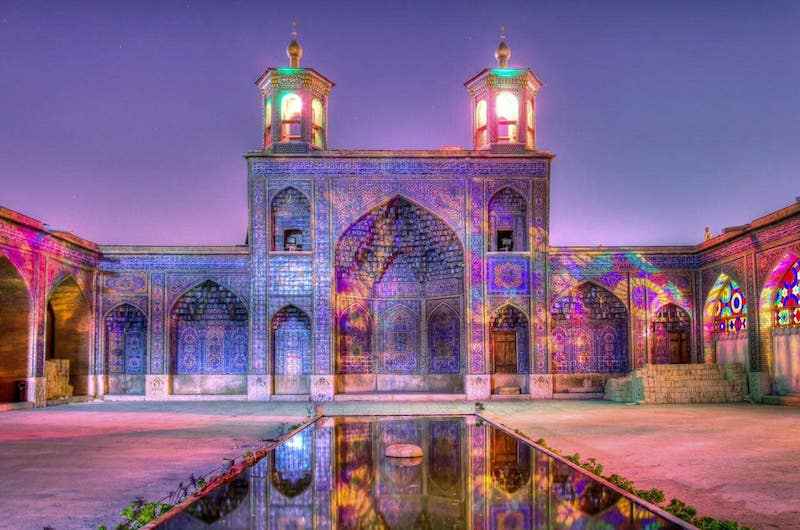
Nasir al-Molk Mosque holds a distinct treasure – its vibrant windows. Sunlight filtering through these windows casts mesmerizing colors across the interior. This creates an enchanting play of light that enhances the sacred ambiance. Stepping into the mosque’s courtyard reveals another layer of charm. Bathed in a gentle pink glow, the courtyard complements the stunning architecture. Inside, the ceiling adorned with pink tiles has earned the mosque its nickname “Pink Mosque.” This endearing name is popular because of its impactful interior design. It has contributed to the mosque’s recognition and popularity among visitors.
History of the Pink Mosque
Nasir al-Molk Mosque was built during the Qajar dynasty. The construction took place under the instruction of Mirza Hassan Ali Khan, also known as Nasir al-Molk, who was the ruler of Shiraz at the time. Furthermore, he decided to build a mosque that would serve as a lasting memory of himself for future generations. At the time, many recognized Nasir al-Molk for his justice and fairness. A member of Ghavam’s large family, he donated much of his property to charity. Some of those endowments still exist today, and his grandchildren oversee the distribution of the proceeds to charitable causes.
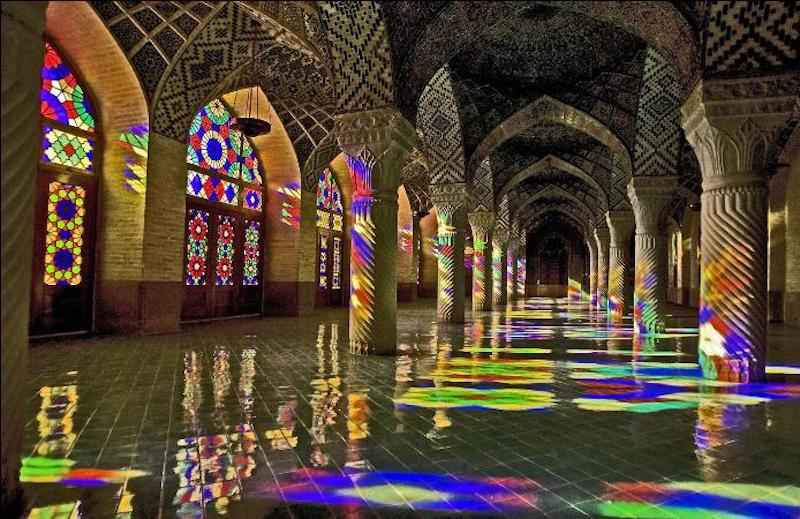
Nasir al-Molk Mosque was built between 1255 and 1267 AH (19th century). Two highly skilled architects at the time, Mirza Reza Kashipaz and Haj Mohammad Hassan Memar, designed and built these structures. Along with the mosque, this complex originally had a residence, a water storage facility, and a bath. Afterward, the subsequent authorities destroyed all of these structures during the development of Lotfali Zand Street, except for the mosque.
Nasir al-Mulk Mosque has undergone two renovations. One repair was done 70 years ago to fix the floor covering, while the other took place from 1370 to 1385 AH. The mosque has been receiving repair and maintenance for many years, following the highest international standards. These endeavors have been funded by the mosque endowments along with other contributions from Nasir al-Molk.
Unlock the fascinating historical narrative of this mosque through the Iran Classic Tour – a must-have experience for history enthusiasts. Within this exclusive collection of tours, we delve into the mosque’s depths through the lens of history.
Architecture of Nasir al-Molk Mosque
Nasir al-Molk Mosque is a must-see attraction when you are in Shiraz. This impressive example of Perso-Islamic architecture is sure to capture your attention immediately. It is worth noting that the mosque does not have a dome as it is private property and not intended as a symbolic structure for public use.
Nasir al-Mulk Mosque covers a total area of 2980 square meters, with its infrastructure covering 2212 square meters. Within its premises, you will find a spacious and well-maintained yard, two naves, two porches, and two garlands. Upon arriving at the entrance, the beautifully detailed muqarnas and tile designs featuring roses and irises of Shiraz will greet you. It’s easy to see why this monument is so beloved.
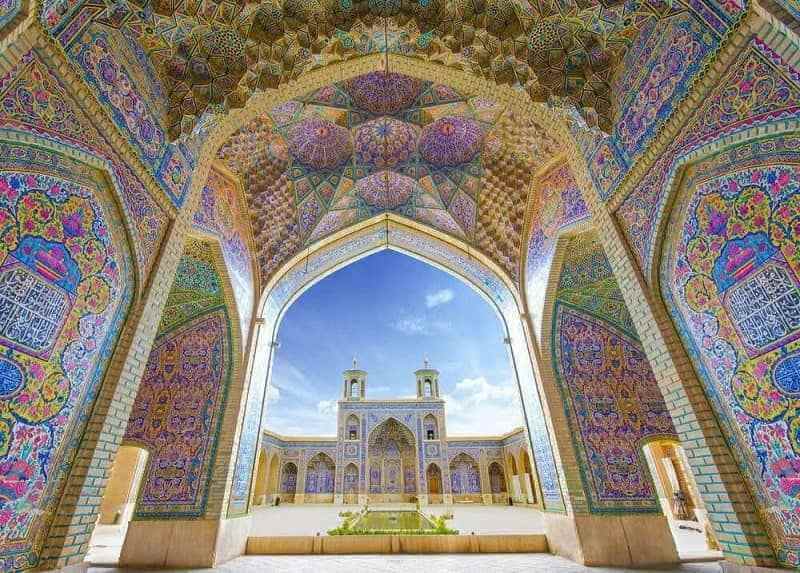
For those seeking to appreciate Nasir al-Molk Mosque from an architectural perspective, our Persian Architecture Tour comes highly recommended. Within this carefully curated collection of tours, we’ve assembled a diverse range of architecturally significant sites for your exploration and enjoyment.
Muqarnas Marvels
Muqarnas, a symbol of detailed Islamic architecture, is beautifully shown in Nasir al-Mulk Mosque. Adorning the ceiling of its winter prayer hall, Muqarnas forms an impressive three-dimensional puzzle of geometric shapes. These carved niches show the advanced mathematical and artistic skill of the craftsmen and envelop worshippers in a celestial experience.
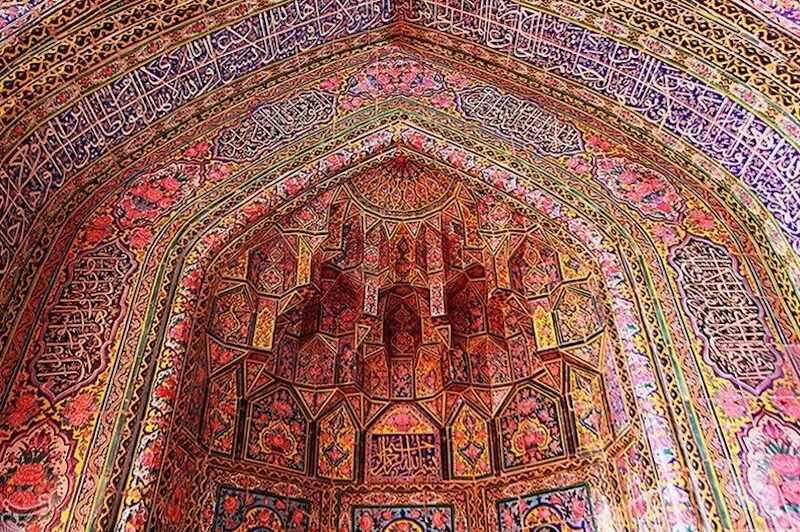
Nasir al-Mulk Mosque’s Muqarnas, as shown above, exemplifies the synergy between form and function in Islamic architecture, offering a visual body of spiritual ascent. This artistry encapsulates the mosque’s role not just as a place of prayer but as a testament to the elegance of design and the devotion of its creators.
Orsi Windows
The Orsi windows within the Nasir al-Mulk Mosque present a charm that transcends mere architectural elements. These carved wooden lattice windows are not just functional openings but artistic masterpieces that weave light and shadow into a mesmerizing tapestry. As the sun’s rays filter through the delicate woodwork, they paint patterns on the inner corners of the mosque, evoking a sense of serenity and spiritual resonance. The Orsi windows, reminiscent of Persian craftsmanship, mirror the sophistication found in carpets and the mosque’s overall design.
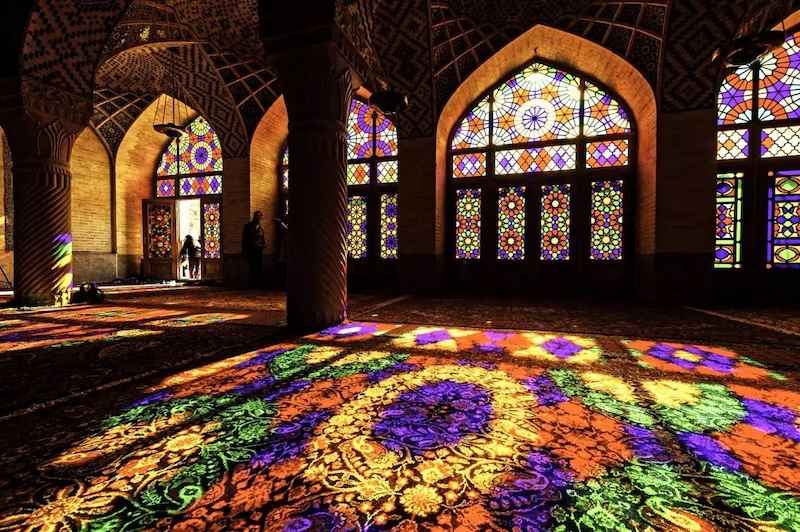
In Nasir al-Mulk Mosque these windows create a dynamic interplay between the external and internal worlds, much like the balance between outer appearances and inner contemplation. The Orsi windows showcase the artistry present in every corner of the Nasir al-Mulk Mosque. They invite visitors to witness the union of aesthetics and spiritual devotion within the heart of Persian architecture.
The Central Pool
In ancient Iranian mosques, pools were present as a part of architectural and Islamic cultural elements. It is noteworthy that in Persian architecture, the term “pool” often suggests a shallow artificial fountain positioned at the center of the structure. The pool in the middle of Nasir al-Molk Mosque serves both practical and aesthetic purposes:
- Aesthetic Enhancement: The pool in the middle of Nasir al-Molk Mosque adds to the overall aesthetic and visual appeal of the interior space. The sound of flowing water from the fountain can contribute to a peaceful atmosphere inside the mosque. Moreover, the soothing sound can create a contemplative space for worship and reflection.
- Cooling Effect: Architects commonly used pools in traditional Persian architecture for their cooling effect. The presence of water can help lower the temperature inside the mosque, providing a more comfortable environment for people who come to pray, especially in hot weather like Shiraz.
- Symbolism: Water holds symbolic significance in Islamic culture. It often represents purity, renewal, and spirituality. Therefore, the presence of a pool could symbolize the spiritual cleansing and renewal of worshippers as they enter the mosque.
- Ritual Cleansing (Wudu): While not necessarily the primary purpose, the pool could also provide a source of water for Muslims to perform ritual ablution (wudu) before their prayers. Wudu is washing specific body parts as a form of cleansing before participating in prayer.
- Architectural Harmony: The placement of the pool in the center of the yard or prayer hall had the intention of creating a sense of balance and symmetry in the overall architectural design.
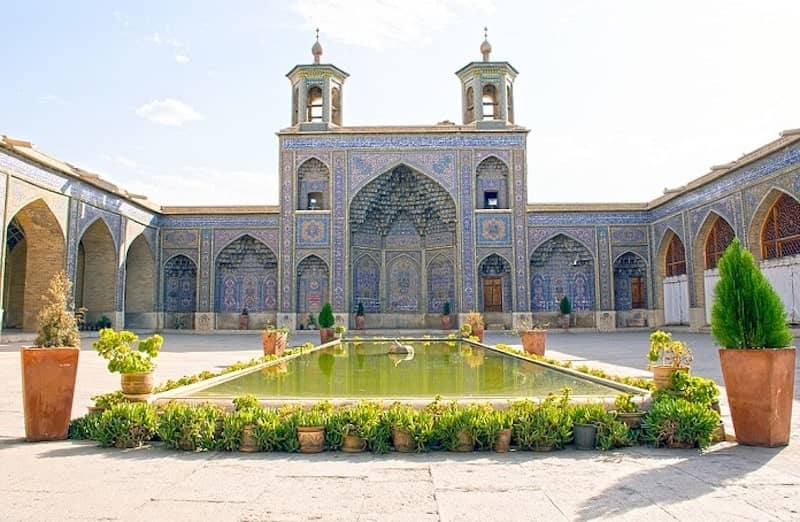
It’s important to note that the exact intentions and purposes behind architectural elements can vary based on cultural, historical, and religious contexts.
The Naves
Nasir al-Molk Mosque is a great example of how architects of that era added a special feature to their designs. Therefore, naves are important parts of Persian mosque designs. They resemble long hallways crafted from tall columns. These columns help divide the space and make the mosque look sophisticated.
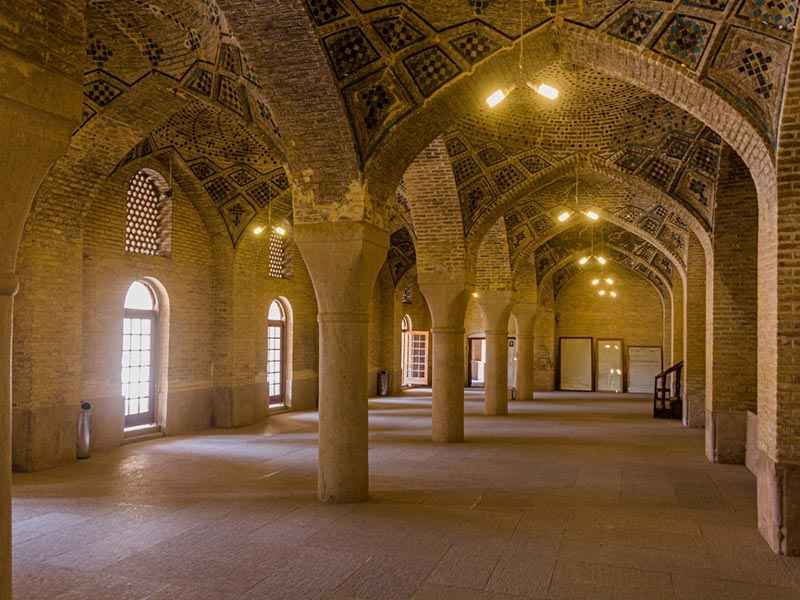
In Nasir al-Molk Mosque, naves play a key role in arranging the space. These naves partition the mosque into distinct eastern and western sections. The columns are unique with precise designs and shapes. They create a pattern that you can see and feel as you are exploring the place. These columns do more than support the structural stability of the mosque – they also work with the colorful stained glass windows to bring in sunlight and make the space feel lively and bright.
Nasir al-Molk Mosque Decoration and Color
In Nasir al-Molk Mosque once we pass through the vestibule and arrive at the quadrangular yard, we will notice several shared features among the mosques of Persia. These include tiling and a rectangular pool located between the yards. These features are present in many of the historical mosques in this region. As you approach the nave’s base in Nasir al-Molk mosque, you’ll notice something special about this religious building. The colored glass windows allow sunlight to filter in, creating a display of colors on the walls and floor. Given that, this beautiful display has made the mosque a popular spot for photographers to capture its unique beauty.
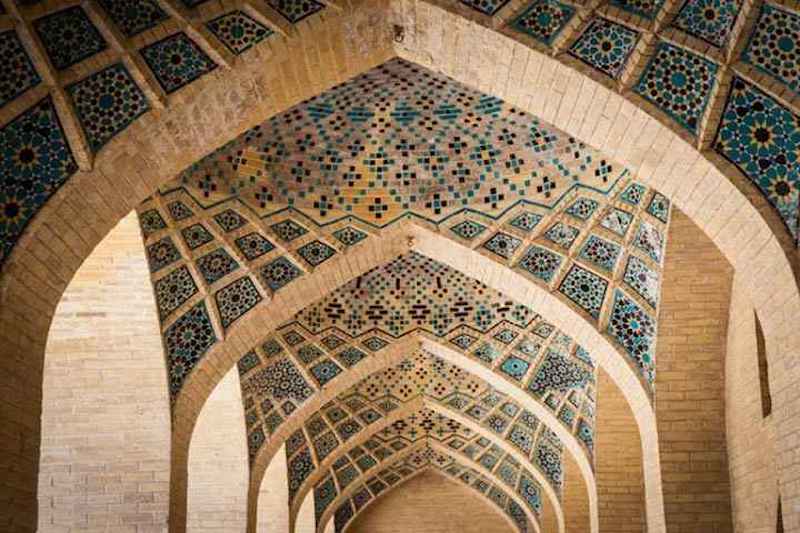
The Mosque & Persian Carpet
Nasir al-Molk Mosque, much like the intricate weaving of a Persian carpet, combines elements of Persian design, geometry, and symbolism in its architecture, thread by thread. The ornate patterns of the mosque’s interior resonate with the elaborate motifs found in Persian carpets. Therefore, it creates a visual harmony that transcends time and culture.
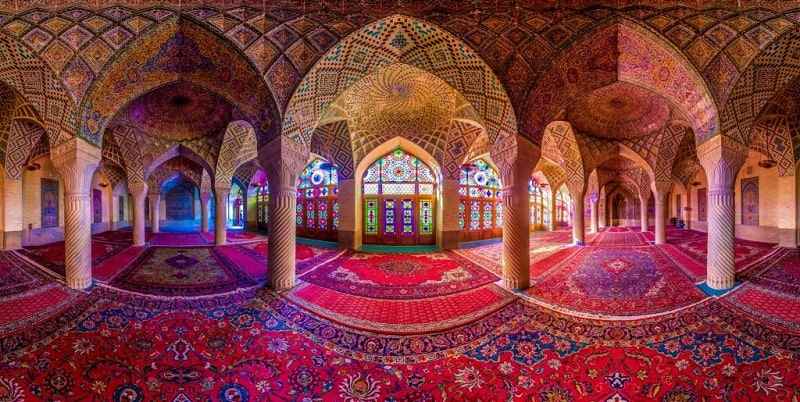
In essence, the Nasir al-Mulk Mosque serves as a living example of the principles that make Persian carpets cherished around the world. It reminds us that art, spirituality, and cultural expression are interwoven threads in the tapestry of human experience. Just as a Persian carpet can transform a room, Nasir al-Molk mosque transforms the spirit of those who enter, enveloping them in a cocoon of serenity and beauty. Much like the soft embrace of a finely woven carpet.
Contrasting Nasir al-Molk with Other Mosques
While the Nasir al-Molk Mosque holds its place among the Persian and Muslim architectural gems, its approach diverges from the conventional norms. Most mosques display geometric patterns and calligraphy. However, Nasir al-Molk Mosque introduces a new dimension with its vibrant and artistic stained glass windows. These windows, akin to vibrant brushstrokes on a canvas, usher in a play of colors that evoke a spiritual connection. This distinctive feature sets it apart from its counterparts, underlining its role not only as a place of worship but also as a testament to innovative architectural expression. Nasir al-Molk Mosque exemplifies how tradition and innovation can create an enduring legacy in the world of mosque architecture.
Nearby Attractions to Nasir al-Molk Mosque
Near Nasir al-Molk Mosque, you’ll discover fascinating tourist spots. Notably, the impressive Karim Khan Citadel, an ancient stronghold, displays Iran’s history. Close by, the Vakil Bazaar allures with its maze-like lanes filled with crafts and spices. Moreover, a visit to the Vakil Bath grants you a glimpse into the realm of Persian architecture. For those intrigued by the evolution of the city, the Pars Museum provides a fascinating insight into how Shiraz has transformed over time.
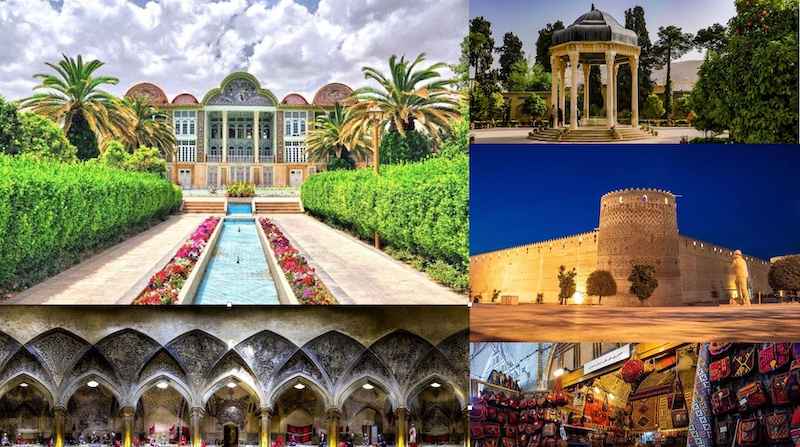
Nature lovers will enjoy the peaceful Eram Garden, a haven of lovely architecture and colorful plants. As the day ends, the Hafez Tomb offers a calm spot by the final resting place of the renowned Persian poet. With these attractions nearby, your visit to Nasir al-Molk Mosque becomes a rich exploration of Shiraz’s history and culture. From ancient forts to serene gardens, the area provides a rewarding journey through Iran’s past and present.
Best Time to Visit Nasir al-Molk Mosque
The optimal time for tourists to visit Nasir al-Molk Mosque in Shiraz is during the early morning hours and late afternoon. As previously mentioned, the position of the sun during morning and sunset casts a gentle and elegant glow. This further improves the atmosphere of the mosque.
Moreover, visiting during weekdays, particularly outside of peak tourist seasons, allows for a more serene and contemplative experience. The reduced crowd levels offer the opportunity to immerse oneself in the beauty and spirituality of Nasir al-Molk Mosque. This allows for appreciating the details and windows without any distractions. Planning a visit between spring and fall ensures pleasant weather, adding to the overall enjoyment of the experience. For a truly memorable encounter with the captivating Nasir al-Molk Mosque, early mornings and late afternoons provide an ideal setting. Combined with good timing during the week, this allows you to immerse yourself in its charm.
A Guide to Visit Nasir al-Molk Mosque
To ensure a memorable visit to Nasir al-Molk Mosque, consider these valuable insights. As mentioned earlier, begin by arriving early in the morning or during the late afternoon, when the gentle sunlight accentuates the mosque’s interior. Additionally, to avoid crowds and immerse yourself in the spiritual ambiance, opt for a weekday visit, particularly outside peak tourist seasons. And, remember to dress modestly as a sign of respect for the sacred space.
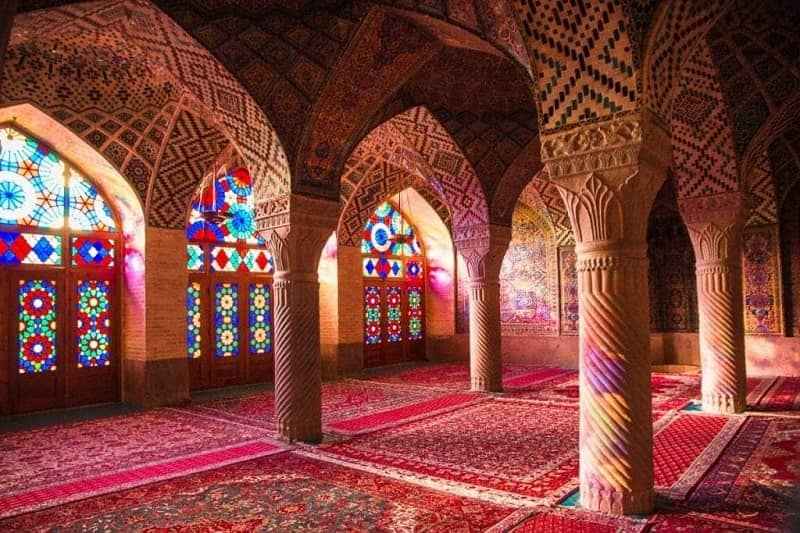
Lastly, take a moment to explore the nearby attractions that complement Nasir al-Mulk mosque’s charm. As mentioned before, the serene Qavam Garden and the historic Karim Khan Citadel are just a few steps away, offering a holistic experience of Shiraz’s cultural heritage. With these guidelines in mind, your visit to Nasir al-Molk mosque promises to be a truly enchanting and enriching journey.
Let the Light Be Your Guide
You might be curious as to why Nasir al-Molk Mosque is worth visiting. Especially with so many grand mosques in Iran to choose from. The reason for the popularity of this mosque mainly lies in its prayer room. Visitors come every day at sunrise to witness the amazing atmosphere created by the sun’s rays hitting the mosaics. In Islam, light represents God and there are verses in the Quran that speak to this symbolism. The purpose of the vibrant Orsi windows was to help worshippers feel more connected to God by illuminating their prayers with a spectrum of colors during morning prayer.
While walking through the different areas of Nasir al-Molk mosque, you can unravel a hundred years of colorful secrets. Nasir al-Molk Mosque’s harmonious blend of art, architecture, and spirituality makes it a must-see destination. It is a place where one can admire its beauty and find solace in the serenity it offers. A visit to this architectural gem promises an unforgettable encounter with the sublime. We believe that here lies the chance to uncover the truth behind this fascinating and enigmatic phenomenon.

